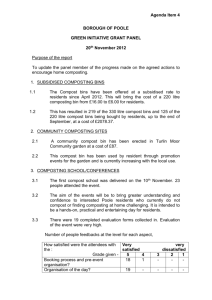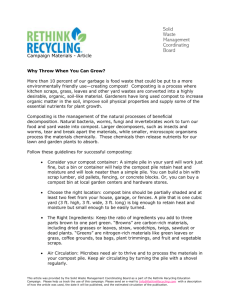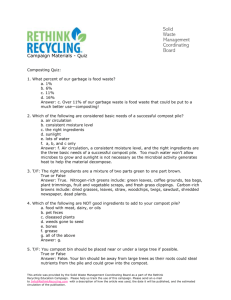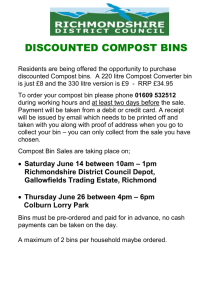May 2014 Residential Article
advertisement
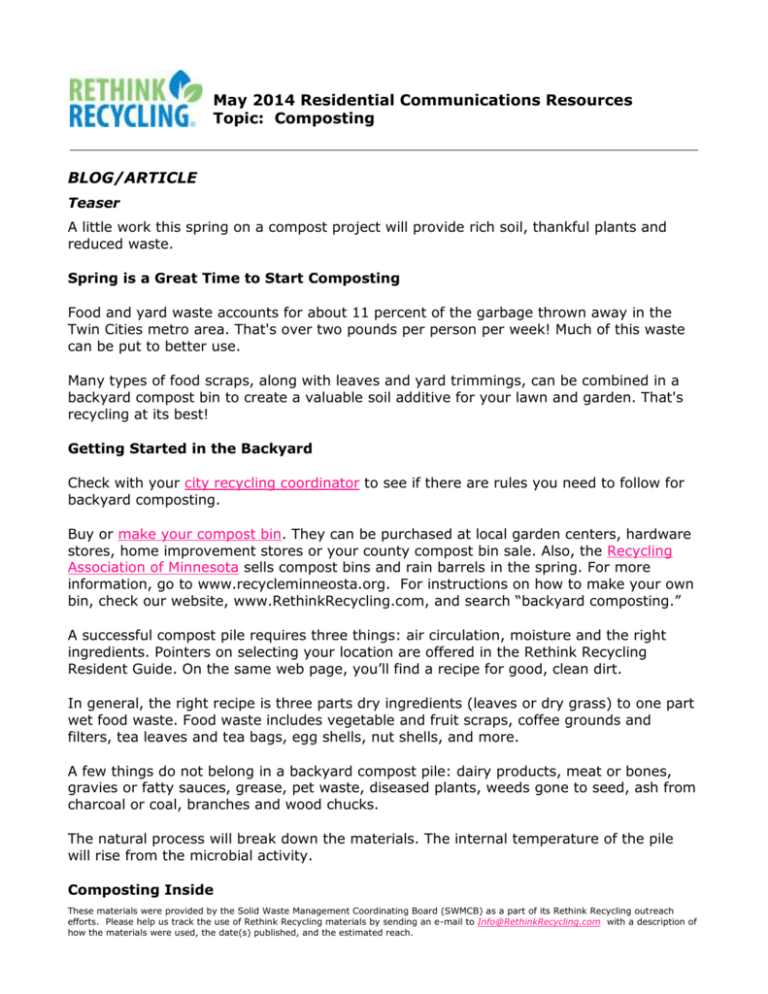
May 2014 Residential Communications Resources Topic: Composting BLOG/ARTICLE Teaser A little work this spring on a compost project will provide rich soil, thankful plants and reduced waste. Spring is a Great Time to Start Composting Food and yard waste accounts for about 11 percent of the garbage thrown away in the Twin Cities metro area. That's over two pounds per person per week! Much of this waste can be put to better use. Many types of food scraps, along with leaves and yard trimmings, can be combined in a backyard compost bin to create a valuable soil additive for your lawn and garden. That's recycling at its best! Getting Started in the Backyard Check with your city recycling coordinator to see if there are rules you need to follow for backyard composting. Buy or make your compost bin. They can be purchased at local garden centers, hardware stores, home improvement stores or your county compost bin sale. Also, the Recycling Association of Minnesota sells compost bins and rain barrels in the spring. For more information, go to www.recycleminneosta.org. For instructions on how to make your own bin, check our website, www.RethinkRecycling.com, and search “backyard composting.” A successful compost pile requires three things: air circulation, moisture and the right ingredients. Pointers on selecting your location are offered in the Rethink Recycling Resident Guide. On the same web page, you’ll find a recipe for good, clean dirt. In general, the right recipe is three parts dry ingredients (leaves or dry grass) to one part wet food waste. Food waste includes vegetable and fruit scraps, coffee grounds and filters, tea leaves and tea bags, egg shells, nut shells, and more. A few things do not belong in a backyard compost pile: dairy products, meat or bones, gravies or fatty sauces, grease, pet waste, diseased plants, weeds gone to seed, ash from charcoal or coal, branches and wood chucks. The natural process will break down the materials. The internal temperature of the pile will rise from the microbial activity. Composting Inside These materials were provided by the Solid Waste Management Coordinating Board (SWMCB) as a part of its Rethink Recycling outreach efforts. Please help us track the use of Rethink Recycling materials by sending an e-mail to Info@RethinkRecycling.com with a description of how the materials were used, the date(s) published, and the estimated reach. Consider worm composting if you want to create a rich soil additive inside your apartment or home. There are two simple requirements, a bin and worms. Much can be learned about both by checking out the Resident Guide on RethinkRecycling.com. Using the Finished Product Worm compost has a higher amount of nitrogen than most compost. Use it sparingly for best results. Mix your indoor or outdoor compost in with your soil to improve quality. Use it to fill in low spots in your yard. Use it as mulch for landscaping and garden plants. Mix compost in the soil for potted plants. Top dress your lawn to retain moisture. Troubleshooting Problems Does your bin stink? Not sure if it’s working? Attracting critters? The Minnesota Pollution Control Agency has a fact sheet, “Diagnosing common backyard composting problems.” You can download the fact sheet by searching for “Good Clean Dirt” at www.RethinkRecycling.com. A little work this spring to get your compost bin going will pay off with rich soil and thankful plants. Social Media Facebook : 1. Check out our new blog on composting. (http://www.rethinkrecycling.com/blog/spring-great-time-start-composting) 2. Food and yard waste equal 2 pounds per person every week in the Twin Cities! Who has tried composting? 3. Indoor composting with worms doesn’t require much space. A bin 8- 16” deep, 2124” long and 14-18” wide is enough. Learn more (link to http://www.rethinkrecycling.com/residents/backyard-composting/compostingworms) 4. Red wiggler composting worms like the same food we do: bread, fruit, coffee grounds and vegetables. But no dairy, meat, onions or fats for the worms. 5. Can you use your composting bin in the winter? You bet. Kitchen scraps that freeze deteriorate and shrink down quickly in the spring. 6. Name something you can put in your backyard composting pile but not in your inside worm composting bin. (Answers: onions, leaves, grass clippings, yard waste) 7. True or false: Compost bins stink. (False: It should smell like dirt, not rotten eggs. Link to page with troubleshooting guide http://www.rethinkrecycling.com/residents/backyard-composting/recipe-goodclean-dirt ) These materials were provided by the Solid Waste Management Coordinating Board (SWMCB) as a part of its Rethink Recycling outreach efforts. Please help us track the use of Rethink Recycling materials by sending an e-mail to Info@RethinkRecycling.com with a description of how the materials were used, the date(s) published, and the estimated reach. 8. What makes a compost pile heat up? The sun? No. As the natural bugs feed on the waste or bacteria in the pile, they generate a lot of heat, which helps the material decompose. 9. Get your compost bin. (Link to RAM info on ordering rain barrels and compost bins at www.recycleminnesota.org.) 10.Looking for recycling bins for your next event? On our website, you can find options for renting, loaning and buying bins. (Link http://www.rethinkrecycling.com/eventplanning/topic/event-recycling-bins) 11.Hennepin, Ramsey and Washington Counties provide free use of event recycling bins. Refundable deposit required in Hennepin. Get the details here (Link http://www.rethinkrecycling.com/event-planning/topic/event-recycling-bins) Twitter: 1. Check out our new blog on composting. (http://www.rethinkrecycling.com/blog/spring-great-time-start-composting) 2. Food and yard waste equal 2 pounds per person every week in the Twin Cities! Who has tried composting? 3. Indoor composting with worms doesn’t require much space. A bin 8-16” deep, 2124” long, 14-18” wide is enough. (link to http://www.rethinkrecycling.com/residents/backyard-composting/compostingworms) 4. Red wiggler composting worms like the same food we do: bread, fruit, coffee grounds and vegetables. But no dairy, meat, onions or fats for the worms. 5. Can you use your composting bin in the winter? You bet. Kitchen scraps that freeze deteriorate and shrink down quickly in the spring. 6. Name something you can put in your backyard composting pile but not in your inside worm composting bin. 7. Answers: onions, leaves, grass clippings, yard waste 8. True or false: Compost bins stink. 9. False: It should smell like dirt, not rotten eggs. (Link to page with troubleshooting guide http://www.rethinkrecycling.com/residents/backyard-composting/recipegood-clean-dirt ) 10.How’s composting work? As natural bugs feed on the waste or bacteria, they generate a lot of heat, which helps the material decompose. 11.Get your compost bin. (Link to RAM info on ordering rain barrels and compost bins at www.recycleminnesota.org.) 12.Looking for recycling bins for your next event? On our website, you can find options for renting, loaning and buying bins. (Link http://www.rethinkrecycling.com/eventplanning/topic/event-recycling-bins) 13.Hennepin, Ramsey and Washington Counties provide free use of event recycling bins. Get the details here (Link http://www.rethinkrecycling.com/eventplanning/topic/event-recycling-bins) These materials were provided by the Solid Waste Management Coordinating Board (SWMCB) as a part of its Rethink Recycling outreach efforts. Please help us track the use of Rethink Recycling materials by sending an e-mail to Info@RethinkRecycling.com with a description of how the materials were used, the date(s) published, and the estimated reach.





